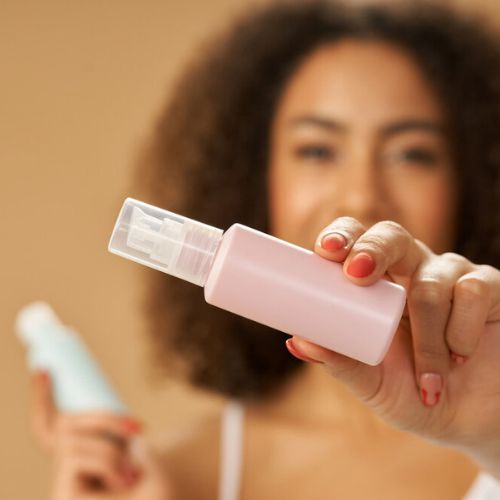Understanding and effectively caring for your unique hair type requires a reliable reference guide. We all start somewhere on our hair care journey, often using hair typing systems like those by Andre Walker or Naturally Curly. As we become more familiar with our hair, we fine-tune our routines, just as we do in other aspects of life.
Every hair type, including 4C hair, benefits from a tailored hair care regimen and a solid grasp of its porosity. Simply buying a bunch of products and hoping for the best won’t yield great results – knowledge is the key to success.
Speaking of 4C hair, it is a unique and beautiful hair type that falls within the spectrum of natural curls. It’s known for its tight, coily texture characterized by densely packed, small curls or zig-zag patterns. Your 4C natural curl pattern is determined during hair formation in utero. Genetics plays a crucial role in determining this pattern during hair follicle formation. Moreover, special chemical bonds are formed in the cortex layer of the hair strand that holds the hair in its natural curvature.1
4C hair type often appears voluminous and has a lot of shrinkage, meaning it can appear shorter than it actually is when stretched. Due to its delicacy, 4C hair thrives with gentle care, deep moisturization, and protective styling.
In today’s blog, we’re shining a spotlight on the specific needs of 4C hair. We’ll delve into its unique characteristics and explore the care it deserves, providing valuable product recommendations to help you maintain its health and vitality. Understanding your hair type is the foundational step in ensuring it gets the care it truly needs.
What is 4C Hair Type?

4C hair is derived from the type 4 kinky hair category. It is a tightly coiled and densely packed curl pattern that is fragile and often has low tensile strength and poor elasticity leaving it prone to damage on easy manipulation.2 This hair type is prone to breakage, tangles, and dryness. It also has significant shrinkage. 4C hair requires extra care and quality moisturizing products.
A general understanding of hair types from the systems is that there are four categories:
- Type 1 (straight)
- Type 2 (wavy)
- Type 3 (curly)
- Type 4 (coily or kinky)

There are also subcategories within each category; A, B, C and 4C hair falls into category 4(refer to the chart below). 4C hair has unique characteristics that make it stand out from the other type 4 subcategories.
Hair Typing Systems

You’ve probably heard about hair typing systems by now. When investigating your hair type, two common go-to sources are Andre Walker’s Hair Typing System and the Curl Type System from NaturallyCurly. But why are such systems necessary?
The road to understanding and embracing your texture can be long and frustrating, especially if you’ve been using the wrong products or techniques. You can find the right products, methods, and styles to help your 4C hair thrive by defining your hair type and learning more about how different textures work.
While everyone doesn’t agree or rely on a “hair typing system” when it comes to their hair, it can help understand your texture and find the right products and techniques that work best for you.
But there is no need to overcomplicate things. Keep it simple and use it as a starting point and “guide.” They are meant to offer general direction, not be the only source of information. Even though hair typing systems aren’t perfect, they can be a great way to start learning about your hair.
There really isn’t a 100% all-encompassing, one-size-fits-all answer to every curl type. Everyone’s hair is unique and different; no two heads are exactly alike (even if someone has a similar hair texture as you).
The key is to experiment and find what works best for you – whether using the products or techniques recommended for your hair type or finding something different that works even better.
Characteristics of 4C Hair

- It is fragile and delicate, with a tightly coiled and densely packed curl pattern.
- There is a low elasticity/tensile strength in 4C hair, which means it is more prone to breakage and damage (if not properly cared for).
- The ability of 4C hair to absorb moisture makes it essential to use products that moisturize and condition your hair regularly.
- It quickly becomes dry and tangled.
- 4C hair is typically coarse or fine in texture.
- Shrinkage occurs the most in the type 4 hair category. Hair shrinkage can be up to 50 – 75%.
- The thickness and size of 4C coils can vary greatly (from thin to thick).
- The curls are so tight that it’s often hard to see the definition.
- The shape of type 4 curls is more like a zig-zag than S-shaped or ringlet curls.
4C Hair Porosity
Hair porosity is how your hair absorbs moisture. To better grasp the idea of hair porosity, it’s helpful to understand the composition of your hair. Your locks are made up of three layers:

The Cuticle: Similar to shingles on a roof, cuticles are the outermost protective layer of your hair. The cuticle layer plays a significant role in determining your hair porosity.
The Cortex: The middle layer that makes up your hair’s bulk (and pigment color). It comprises long keratin filaments held together by disulfide and hydrogen bonds. The health of the cortex largely depends on the strength (integrity) of the cuticle.
The Medulla: Located in the innermost layer of the hair shaft, that is the softest and most fragile. The medulla is continuous among people who live in cold climates and appears interrupted in people living in the tropics.
Your hair stays healthy and hydrated when water, oils, and other moisturizing products pass through the cuticle to reach the cortex. When your cuticles are lying flat and tightly closed, it becomes difficult for water and oils to penetrate the hair strands.
This creates difficulties in moisture absorption, and as a result, your hair may become dry. When your cuticles are wide open, the hair easily lets moisture in, but it is harder for your hair to retain moisture and stay hydrated as it loses it as fast to the environment.
Porosity is determined by how easily your hair can absorb water and products. If your hair has difficulty absorbing water and products, then it’s very likely that you have low-porosity hair. If your hair tends to absorb water too quickly and easily, you likely have high-porosity hair.
Medium (normal) porosity has neither too close nor open cuticles. This allows easy moisture penetration and easier moisture retention for extended periods. Hair that colors well is easy to style and can hold styles, doesn’t take too long for your hair to air dry, tends to look healthy, and may have medium porosity.
4C Hair Tips for Low Porosity

One of the main challenges with low porosity 4C hair is that it can sometimes be difficult for moisture to penetrate the cuticle, which means that your hair may become dry and brittle over time. You can use specific tips to help moisturize your 4C hair and keep it healthy and hydrated.
The first step is to work on sealing in moisture with a good conditioner or oil. This can help improve its ability to hold onto moisture and keep your 4C hair hydrated. Another useful tip is to use a co-wash, low-poo, or color-safe shampoo that gently cleanses your 4C hair without stripping it of its moisture.
You can also try using heat to open the cuticles and help moisture to penetrate your 4C hair. A hot oil treatment, microfiber towel, or steam cap can all help improve moisture retention and keep your 4C hair looking healthy and hydrated.
There are two ways to hydrate and moisturize hair. Both strategies work together in hair care science to not only add water molecules but also preserve those that are already there.
- Butter and oils work on the hair’s surface to lubricate the 4C hair cuticle and lock in moisture, making styling 4C hair much smoother.
- Emollients and Humectants impart water molecules to the hair fiber, boosting hair moisture content.
Hydrating products include ingredients such as:
- Aloe vera
- Flaxseed
- Glycerin
- Honey
- Small proteins (amino acids)
- Sorbitol
4C Hair Tips for High Porosity
Although high-porosity hair can quickly absorb moisture, it can lose it just as easily. You can address this by sealing moisture using deep conditioning treatments containing penetrating ingredients like oils and butter. It is also good to incorporate protein treatments (when needed).
Another important step is to avoid products and styling tools that can damage your 4C hair, such as heating tools without a proper protective barrier or using unregulated excessive heat. Harsh chemicals that strip your 4C hair’s natural oils should also be avoided.
Properly hydrating and moisturizing 4C hair requires a combination of surface and deep treatments and careful consideration of your products and tools. However, With the right strategies, you can keep your 4C hair healthy and hydrated no matter the season.
How To Keep 4C Hair Healthy

Most people have no idea how to care for 4C curls, so a regular curly hair routine won’t cut it. 4C hair is tightly coiled, often fragile, and prone to breakage and moisture loss. To care for 4C coils, prioritize moisture and avoid harsh chemical treatments.
Here are a few tips for keeping your textured hair healthy and easier to manage:
Moisturize, Moisturize, Moisturize!
Everyone knows that curly hair is dry, but many people don’t know that 4C curls are the driest. Regularly moisturizing your hair is key to maintaining healthy, strong locks.
Without proper hydration, these coils become brittle and weak- almost to the point where they feel like straw when you touch them. Not only does this damage the curl pattern, but it can also lead to breakage and split ends.
Although all conditioners appear to serve the same purpose, they are not all formulated equally. There are three types of conditioners:
Best 4C Conditioners
Rinse-Out Conditioners:
Rinse-out conditioners only hydrate the outer layer of your hair. They are made with larger molecules that do not penetrate through to the inner layers of the hair but help soften and hydrate the strands from the outside making the hair easy to comb and manage.4
Leave-In Conditioner/Treatments:
Leave-in conditioners are lightweight styling products that help to enhance moisture retention, control frizz, and make detangling much easier. They create a barrier around the hair cuticle and smooth the hair shaft. Using a leave-in conditioner in conjunction with other hair care products is best. They can be applied on wet or dry hair and are not rinsed out.
Deep Conditioners:
Deep conditioners go a step further by penetrating the hair shaft. They are made with small molecules that can penetrate the cortex layer and impact moisture. This helps hair to retain (and restore) moisture, bolster elasticity, and may even mend some damage.
Be Gentle When Detangling
Regularly detangling 4C hair may seem tedious, but it’s necessary to maintain healthy length and prevent breakage. The very tight curl pattern of 4C causes it to tangle much quicker than other textures. Without taking proper care of your hair, it will become matted.
Those with 4C hair need to be extra careful when combing their hair, as even one session can result in disastrous breakage.
Detangle your hair while wet and saturated in a product for the best care. Remember that hair’s tensile strength is significantly reduced when wet and can break easily. Hair is at its weakest when wet and a lot of care is needed if combing or detangling your hair when wet.
Or, pre-poo with conditioner or oils to soften the strands and reduce friction. It’s best to use a wide-tooth comb, detangling brush, or your fingers to gently pull apart kinks and knots. Never yank, as this can cause it to break and snap off. Always detangle your hair and comb it from the tip to the root and never the other way round to avoid hair damage.
Best 4C Detangler
Don’t Forget Your Scalp Health
A healthy scalp is paramount to healthy hair, regardless of curl type. This is especially important for those with 4C curls who love using products on their hair.
To keep your scalp in top condition, incorporate routine practices like a pre-poo or scalp scrub. You can also add oil to your scalp to hydrate and prevent itching and irritation.
Although washing your hair is crucial to a healthy scalp, you don’t need to shampoo every time you shower. To achieve the best results, alternate washing your hair with a co-wash and sulfate-free shampoo. When washing your hair, it is best to divide it into small sections to avoid tangles.
Best 4C Shampoos / Co-Wash
Take Care of Your Ends
The ends of our curls are the oldest part of our hair, which means they can become brittle, dry, and fragile over time. To keep your 4C ends looking and feeling their best, use a high-quality moisturizing product daily. You can also seal them with oil using the LOC or LCO method.
The LOC/LCO method is an excellent way to hydrate and moisturize your hair. The letters in the LOC method tell you how to use your hair products. You start by adding a leave-in conditioner, an oil, and a cream to act as a sealant. Using the LCO method, you start by applying a leave-in conditioner. Then, add curl cream to your routine. Finally, finish by sealing in moisture with oil. Both methods help your 4c hair achieve a softer, more defined curl pattern while reducing dryness and frizz.
Best Oils for 4C Hair
Don’t Skip Trims
It’s important not to skip out on regular trims. Regular trims help to keep 4C hair looking healthy, free from split ends, and retain length!
Though you may appear to have shorter hair at first, stick with the trims–you’ll notice healthier, stronger strands over time!
Change Your Pillowcase
It’s also important to be mindful of the bedding and materials that you sleep on. 4C hair, in particular, is vulnerable to breakage, which can be exacerbated by rubbing against coarse or harsh materials.
Traditional cotton pillowcases can strip your hair of moisture overnight, leading to a dry and lifeless look by morning. Invest in a satin pillowcase instead. You can also use a satin bonnet, scarf, or wrap during the night to help protect your 4C hair while you sleep.
4C Hairstyles
A video tutorial is a far better way to show you how to style your hair than simply listing a bunch of hairstyles! Check it out below.
Use protective styling to your benefit
If you have 4c hair, you know that protective styling can be your best friend. Protective styles like wearing your hair in bantu knots, twists, or braids, help to keep your strands from being damaged by harsh weather and everyday activities. It also prevents split ends since most protective styles tuck the ends away.
Protective styles will only protect your hair if done without applying strain or too much manipulation on your hair. So as you wear your bantu knots, twists, or braids, ensure they are loosely done, hair extensions are not too heavy and not tightly styled to avoid causing permanent damage to your hair and hair follicles.
Best 4C Styling Products
Ingredients to Avoid on 4C Hair
- Sulfates in and of themselves are not bad. However, when used in excess, they can cause irritation, dryness, and other adverse effects.
- Sodium Lauryl Sulphate, Ammonium Lauryl Sulphate, TEA Lauryl Sulphate, and Sodium Laureth Sulphate are the most common sulfates in shampoos and other hair care products.
- Some ingredients to avoid in 4C hair products include sulfates, silicones, drying alcohols, and heavy oils. These may dry out your hair and scalp.
- Mineral oils and petroleum products should generally be avoided, as they can clog your pores and prevent 4C hair from absorbing moisture.
- Phthalates should be avoided, as they are commonly used in hair and beauty products to help them stick to the skin. However, they have been known to cause irritation and other adverse effects, especially when used in products meant to be applied near the scalp. However, according to the FDA, evidence is lacking that cosmetic phthalates pose a safety risk.
Summary
4C hair may be rare, but now you don’t have to wonder how to care for it. Remember, your 4C hair needs gentleness, love, and moisture! Use what works for your hair’s specific needs and if something isn’t working, eliminate it and try another!
References
- Wortmann, F. J. (2020, March). PupMed. From Why is hair curly?-Deductions from the structure and the biomechanics of the mature hair shaft. ↩︎
- Ezure, M. (2019, July). ReserachGate. From The Secrets of Beautiful Hair: Why is it Flexible and Elastic? ↩︎
- McMullen, R. L. (n.d.). ResearchGate. From https://www.researchgate.net/figure/Images-of-various-types-of-hair-illustrating-their-diversity-in-shape-Type-I-is-classifi_fig1_289528406 ↩︎
- Fernandes, C. (2023, February). PupMed. From On Hair Care Physicochemistry: From Structure and Degradation to Novel Biobased Conditioning Agents. ↩︎















